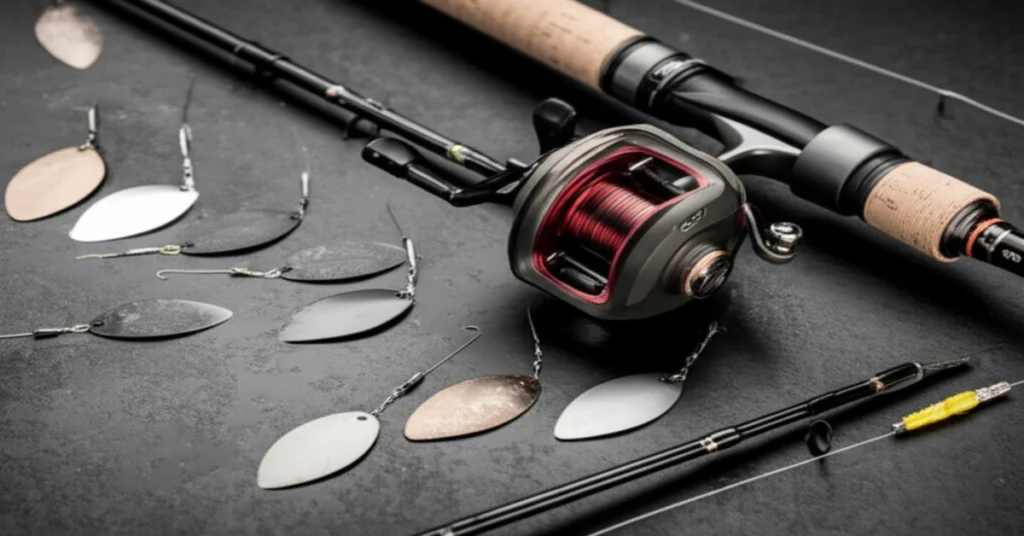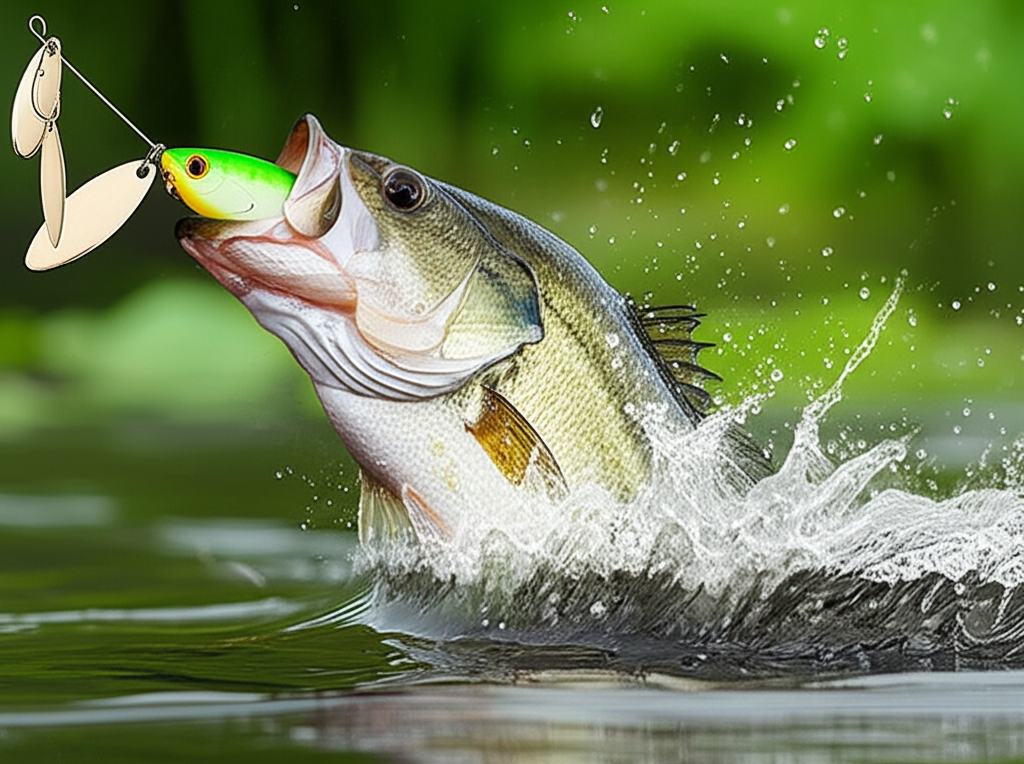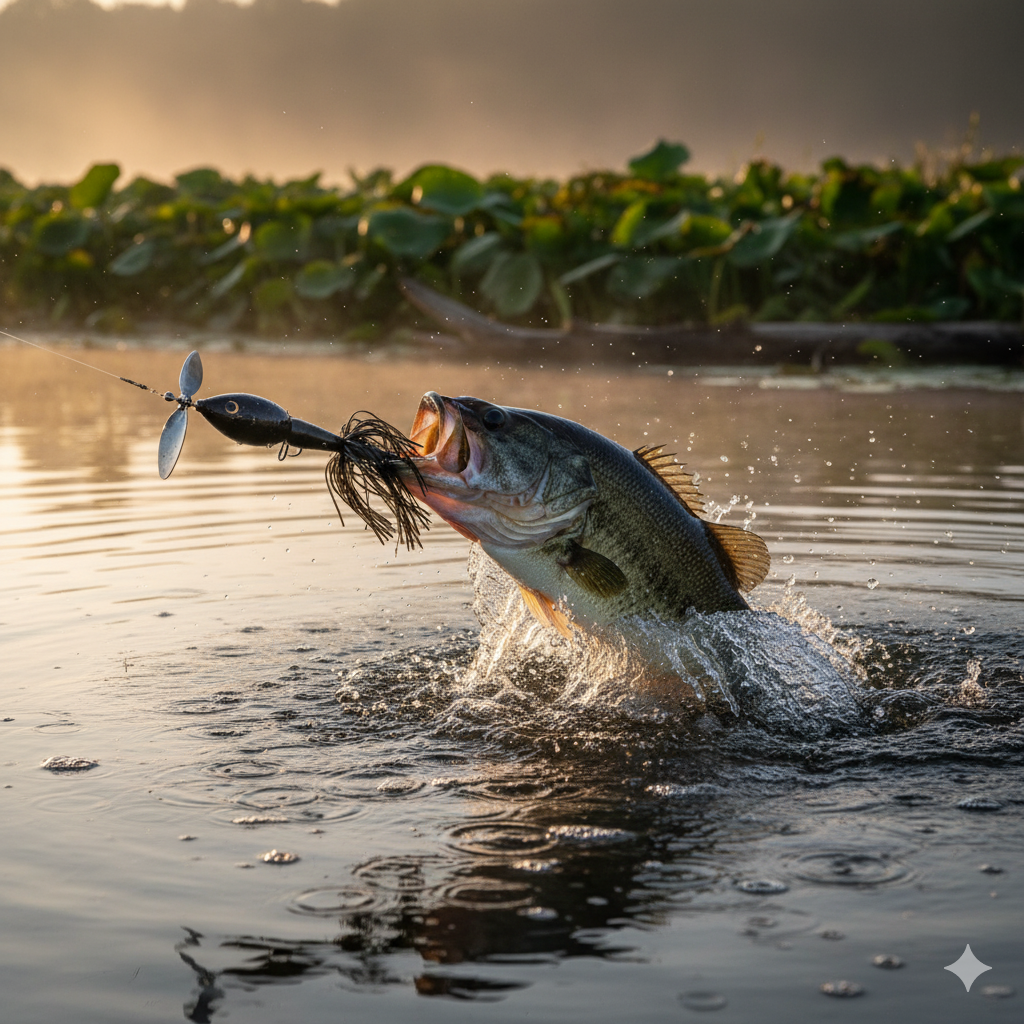Mastering Spinnerbait Fishing Gear: The Ultimate Guide
There’s no feeling quite like the distinctive ‘thump’ of a big bass inhaling a spinnerbait. But too often, that exciting bite doesn’t translate into a fish in the boat, leaving anglers frustrated and confused. The problem usually isn’t the lure itself—it’s the mismatched spinnerbait fishing gear used to present it. An unbalanced setup can lead to poor casting, missed hooksets, and lost fish, turning a promising day on the water into a lesson in what-ifs. This guide is your definitive solution, designed to demystify every component of the perfect spinnerbait system.
From the specific bend in the rod to the speed of the reel, we’ll cover everything you need to know to build a high-performance setup. Whether you’re a beginner just discovering the magic of these bladed baits or a seasoned pro looking to refine your approach, understanding the nuances of your spinnerbait fishing gear is the single most important factor for consistent success. Prepare to transform your spinnerbait game from inconsistent to unstoppable.
Table of Contents
- What is spinnerbait fishing gear?
- Key Benefits and Importance
- Complete Step-by-Step Guide
- Expert Tips & Best Practices
- Common Mistakes to Avoid
- Advanced Strategies for 2024/2025
- Essential Tools & Resources
- Frequently Asked Questions
What is spinnerbait fishing gear?
Spinnerbait fishing gear is not just a lure; it’s a complete, synergistic system of components working in harmony to maximize the effectiveness of a spinnerbait. It’s the carefully selected combination of a rod, reel, line, and terminal tackle, all chosen for their specific performance characteristics that complement this unique bait. When assembled correctly, this specialized setup enhances lure action, casting accuracy, and, most importantly, your hook-up ratio.
A truly optimized system involves a specific spinnerbait fishing rod with the right action, a spinnerbait fishing reel with a suitable gear ratio, and the correct type of spinnerbait fishing line. The entire collection of these items constitutes your spinnerbait fishing tackle. Key details like the ideal spinnerbait rod action, a versatile spinnerbait reel ratio, and the appropriate spinnerbait line weight are not minor preferences but critical factors for success. Furthermore, elements like a proper spinnerbait leader setup for certain line types and razor-sharp spinnerbait hooks are the final touches that complete this high-performance spinnerbait equipment.
Key Components
- The Rod: Typically a medium-heavy power rod with a moderate-fast action, which provides the backbone to pull fish from cover but has enough tip flexibility to prevent pulling the hooks.
- The Reel: A baitcasting reel is preferred for its power and control. A moderate gear ratio (e.g., 6.4:1 to 7.3:1) offers the most versatility for different retrieve speeds.
- The Line: Fluorocarbon or monofilament lines in the 14-20 lb test range are standard, as their properties are well-suited for spinnerbait presentations and shock absorption.
- The Lure & Terminal Tackle: This includes the spinnerbait itself, with various blade combinations (Willow, Colorado, Indiana), and often a trailer hook to catch short-striking fish.
Why spinnerbait fishing gear Matters: Key Benefits
Using a dedicated, properly matched spinnerbait fishing gear setup isn’t about being a gear snob; it’s about efficiency and effectiveness. Anglers who use specialized gear report a significant increase in their landing percentages. The right setup acts as an extension of your body, translating feel and intuition into precise lure control and powerful hooksets. This system allows you to cover water faster, detect subtle bites, and ultimately put more fish in the boat.
Increased Hook-Up and Landing Ratio
The single greatest benefit is an improved hook-up ratio. A common mistake is using a rod that’s too stiff or fast. When a bass strikes a spinnerbait, it often engulfs the entire lure. A rod with the correct spinnerbait rod action (moderate-fast) has a slight delay in its backbone, giving the fish an extra split second to fully take the bait before you feel the bite and set the hook. This small delay prevents you from prematurely ripping the lure, and its sharp spinnerbait hooks, out of the fish’s mouth, dramatically increasing your landing success.
Enhanced Lure Performance and Versatility
Your spinnerbait fishing gear directly influences the lure’s action. A balanced rod and reel combo allows for effortless casting and precise retrieves. The right spinnerbait reel ratio enables you to maintain the perfect speed to keep the blades turning correctly—whether you’re burning it just under the surface or slow-rolling it along the bottom. This control makes the spinnerbait one of the most versatile lures in your entire collection of spinnerbait fishing tackle, effective in cold or warm water, clear or muddy conditions, and from open water to the heaviest cover.
“A perfectly tuned spinnerbait setup isn’t just a collection of parts; it’s a high-performance system designed to turn flashes of interest into fish in the boat. Every piece, from the rod tip to the line, plays a critical role.”
Complete Guide to Assembling Your spinnerbait fishing gear – Step-by-Step
Building the ideal spinnerbait fishing gear setup is a straightforward process when you know what to look for. Follow these three steps to create a perfectly balanced system that will give you a distinct advantage on the water. This guide ensures every piece of your spinnerbait equipment works together seamlessly.
Step 1: Selecting the Perfect Spinnerbait Fishing Rod
The rod is the foundation of your entire setup. For spinnerbaits, you want a casting rod that offers a unique blend of power and forgiveness. Avoid stiff, extra-fast action rods common for jig fishing.
- Length and Power: Choose a rod between 7’0″ and 7’4″ in length with a Medium-Heavy power rating. This provides excellent casting distance and the backbone needed to manage strong fish in cover.
- Critical Factor – Spinnerbait Rod Action: This is non-negotiable. Look for a Moderate-Fast or “Mod-Fast” action. This specific spinnerbait rod action allows the tip to load up during a cast for maximum distance and provides the slight delay needed for better hooksets.
- Expected Outcome: A rod that can launch spinnerbaits accurately, absorb the shock of a strike, and keep fish pinned all the way back to you.
Step 2: Choosing the Ideal Spinnerbait Fishing Reel
Your reel is the engine of the system. While a spinning reel can work, a baitcasting reel offers superior control, power, and efficiency for this technique. The most important specification to consider is the gear ratio.
The optimal spinnerbait reel ratio provides a balance between speed and power. A ratio between 6.4:1 and 7.3:1 is considered the versatile sweet spot. This range is fast enough to quickly pick up slack line and burn a bait when needed, yet slow and powerful enough for methodical, deep-water slow-rolling. This choice of spinnerbait fishing reel will cover over 90% of your needs.
Step 3: Spooling the Correct Spinnerbait Fishing Line
The final connection between you and the fish, your line choice, is crucial. The properties of the line, especially stretch and visibility, can make or break your success. The ideal spinnerbait fishing line should be strong and abrasion-resistant.
For your primary line, choose either 14-20 lb test fluorocarbon or monofilament. Fluorocarbon is popular because it’s nearly invisible underwater and has low stretch for sensitivity, but it’s also stiffer. Monofilament has more stretch, which can be very forgiving and help keep fish hooked. The recommended spinnerbait line weight depends on cover; use a heavier line in thick vegetation or wood. If you prefer using braided line for its strength, always use a spinnerbait leader setup consisting of an 18-24 inch fluorocarbon or monofilament leader to reduce visibility and add a bit of shock absorption.
Expert Tips & Best Practices for spinnerbait fishing gear
Once your spinnerbait fishing gear is assembled, applying the right techniques and practices will elevate your results. Whether you’re just starting or looking to refine your skills, these tips will help you get the most out of your setup. These practices apply to your entire range of spinnerbait equipment.
For Beginners:
- Master the Steady Retrieve: Before trying complex retrieves, perfect the simple cast-and-wind. Focus on feeling the blades thump through your spinnerbait fishing rod. This teaches you the optimal speed to keep the lure working correctly.
- Use a Trailer Hook: Fish, especially largemouth bass, will often swipe at a spinnerbait. Adding a trailer hook to your main spinnerbait hooks significantly increases your hook-up percentage on these short strikes. It’s a simple addition to your spinnerbait fishing tackle that pays huge dividends.
- Start with a Versatile Lure: Don’t get overwhelmed by lure choice. Begin with a 1/2 oz white or chartreuse spinnerbait with a combination of one willow and one Colorado blade. This is a proven fish-catcher in a wide variety of conditions.
For Advanced Users:
- Tune Your Wire Frame: An “out-of-the-box” spinnerbait isn’t always perfect. You can slightly open the R-bend of the wire arm. This makes the lure vibrate more intensely and can help it deflect off cover better, triggering more reaction strikes.
- Match Blades to Conditions: Go beyond the standard. Use tandem willow blades for speed and flash in clear water. Switch to large, single Colorado blades for maximum vibration, or “thump,” in muddy water or at night. This level of detail transforms your approach.
5 Common spinnerbait fishing gear Mistakes to Avoid
Even with the best spinnerbait fishing gear, common mistakes can sabotage your efforts. Identifying and avoiding these pitfalls is crucial for consistent success. Many anglers blame the lure when the problem lies in their application of the spinnerbait equipment.
Mistake #1: Using a Rod with the Wrong Action
The Problem: An extra-fast action rod is too stiff. When a fish bites, this rod rips the lure away before the fish can fully eat it, resulting in missed opportunities. The wrong spinnerbait rod action is the most frequent error.
The Solution: Stick to a moderate-fast action spinnerbait fishing rod. This softer tip acts as a shock absorber, giving the fish that critical moment to commit to the bait, ensuring your spinnerbait hooks find their mark.
Mistake #2: Choosing an Inappropriate Reel Speed
The Problem: Using a very fast reel (8.1:1 or higher) can make it difficult to slow down, causing you to retrieve the lure too quickly and unnaturally. Conversely, a very slow reel makes it hard to catch up to a fish swimming towards you.
The Solution: Select a versatile spinnerbait reel ratio in the 6.4:1 to 7.3:1 range. This gives you the perfect balance for most situations you’ll encounter with your spinnerbait fishing reel.
Mistake #3: Neglecting Line Choice and Weight
The Problem: Using straight braid is a common error. Its lack of stretch can easily tear hooks from a fish’s mouth. Using a line that is too light can lead to break-offs in cover.
The Solution: Choose a 14-20 lb test fluorocarbon or monofilament line. If you must use braid, learn to tie a proper spinnerbait leader setup. Always match your spinnerbait line weight to the type of cover you are fishing.
Mistake #4: Not Checking Hook Sharpness
The Problem: Spinnerbaits are frequently fished through rocks, wood, and dense vegetation, which quickly dulls the hook point. A dull hook will not penetrate a fish’s hard mouth, leading to lost fish at the boat.
The Solution: Carry a small hook file in your boat or tackle bag. Check your spinnerbait hooks every few casts and after snagging any cover. A few quick strokes with a file can make all the difference.
Mistake #5: Fishing with a Straight Retrieve Only
The Problem: While a steady retrieve works, fish can become conditioned to it. Constantly retrieving at the same speed makes the lure predictable and less enticing to neutral or pressured fish.
The Solution: Vary your retrieve. Add pauses, quick twitches of the rod tip, or speed up your retrieve for a few cranks. Making the spinnerbait act erratically mimics fleeing or injured baitfish and triggers aggressive strikes.
Advanced spinnerbait fishing gear Strategies for 2024/2025
As fishing pressure increases and technology evolves, so do the techniques. These advanced strategies for your spinnerbait fishing gear can unlock new opportunities and help you stay ahead of the curve. These methods require a deep understanding of your entire spinnerbait equipment setup.
Targeting Suspended Fish with Forward-Facing Sonar
The rise of live, forward-facing sonar has changed the game. Instead of just casting to visible cover, you can now target individual fish suspended in the water column. Use a heavier spinnerbait (3/4 oz to 1 oz) and a sensitive spinnerbait fishing rod. Watch your screen to see how fish react as you let the lure helicopter down or “yo-yo” it through their zone. This precision tactic is incredibly effective for converting suspended, inactive fish that other anglers miss.
Finesse Spinnerbaiting in Clear, Pressured Waters
When bass are finicky, downsizing your entire system can be the key. This involves using a smaller, more compact spinnerbait (1/4 oz or 3/8 oz) on lighter spinnerbait fishing gear. Opt for a medium-power rod, a smaller reel, and a lighter spinnerbait line weight like 10-12 lb fluorocarbon. This subtle presentation is deadly in clear water or on fisheries that see heavy fishing pressure, where a standard-sized offering might spook wary fish.
Essential Tools & Resources for spinnerbait fishing gear
Having the right spinnerbait fishing gear is the first step, but a few key tools and resources can make your time on the water more efficient and successful. These accessories complement your primary spinnerbait equipment perfectly.
Recommended Tools:
- Hook File/Sharpener: Absolutely essential. A diamond grit hook file keeps your spinnerbait hooks dangerously sharp for instant penetration.
- Split Ring Pliers: Allows you to easily change out blades, swivels, or hooks on your spinnerbaits, letting you customize your lure on the fly to match conditions.
- Trailer Hooks & Keepers: A small box dedicated to various sizes of trailer hooks and the rubber keepers to hold them in place. This is a must-have part of any serious angler’s spinnerbait fishing tackle.
Additional Resources:
- Online Fishing Forums: Websites like BassResource.com have decades of archived discussions on every nuance of spinnerbait fishing, from rod selection to advanced modifications.
- Mobile Angling Apps: Apps like Fishbrain or Anglr can help you log catches, track effective lure colors, and note water conditions, creating a valuable personal database for future trips.
Frequently Asked Questions About spinnerbait fishing gear
Q1: What is the best all-around setup for a beginner’s spinnerbait fishing gear?
Answer: For a versatile, all-around setup, start with a 7’0″ to 7’3″ medium-heavy power, moderate-fast action spinnerbait fishing rod. Pair it with a baitcasting spinnerbait fishing reel featuring a spinnerbait reel ratio around 7.1:1. Spool it with 17 lb test fluorocarbon spinnerbait fishing line. This complete set of spinnerbait equipment will handle most situations effectively and is forgiving for new anglers learning the feel. The specified spinnerbait rod action and spinnerbait line weight are key.
Q2: How important is the spinnerbait leader setup?
Answer: The spinnerbait leader setup is only necessary if you are using braided line as your main line. Braid is extremely strong and sensitive but is highly visible underwater and has no stretch. Adding a 2-foot section of 15-20 lb fluorocarbon or monofilament leader makes your presentation more stealthy in clear water and adds a small amount of shock absorption to prevent tearing out the hooks.
Q3: Can I use one rod for both jigs and spinnerbaits?
Answer: While you can, it’s not ideal. A typical jig rod has an extra-fast action, which is designed for instant, powerful hooksets on single-hook baits. This action is too stiff for a spinnerbait and often leads to pulling the lure away from the fish. A dedicated spinnerbait fishing rod with a moderate-fast action will significantly improve your landing percentage with moving baits.
Q4: How do I choose between different spinnerbait blade types?
Answer: It’s simple: willow blades are for flash, and Colorado blades are for thump (vibration). Use tandem willow blades when you want to fish fast and imitate baitfish in clearer water. Use a large single Colorado blade when you need maximum vibration in muddy water, at night, or when you want to slow-roll the bait and keep it higher in the water column.
Conclusion: Master spinnerbait fishing gear for Long-term Success
Achieving consistent success with one of bass fishing’s most iconic lures goes far beyond just tying it on. As we’ve detailed, mastering your spinnerbait fishing gear is about creating a finely-tuned system where every component works in concert. From rod action to line type, each choice directly impacts your ability to present the lure effectively and, more importantly, to land the fish that bite.
As you move forward, continue to refine your setup. Pay attention to how small adjustments to your spinnerbait fishing rod, spinnerbait fishing reel, or spinnerbait fishing line affect your results. The principles of a balanced system are timeless, and by investing in the right spinnerbait equipment and understanding how to use it, you’re not just buying tackle; you’re building a foundation for angling success for years to come. Your understanding of everything from the spinnerbait reel ratio to the spinnerbait hooks will set you apart.
Related Articles You Might Find Helpful:
- Deep Dive: The Ultimate Guide to Choosing the Right Spinnerbait Rod Action
- Fluorocarbon vs. Monofilament: The Definitive Spinnerbait Fishing Line Debate
- Advanced Spinnerbait Fishing Tackle: Customizing Blades, Skirts, and Hooks
What’s Your spinnerbait fishing gear Experience?
What’s your go-to rod and reel combination for spinnerbaits? Share your favorite setup or any tips you’ve discovered in the comments below!
Note: This guide reflects current best practices and is updated regularly to ensure accuracy. Last updated: October 17, 2023



